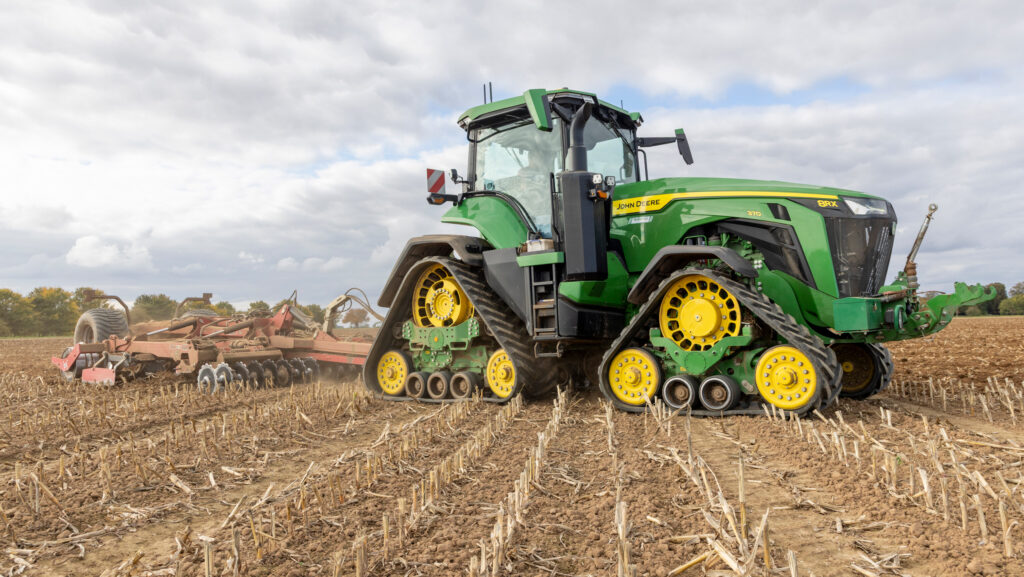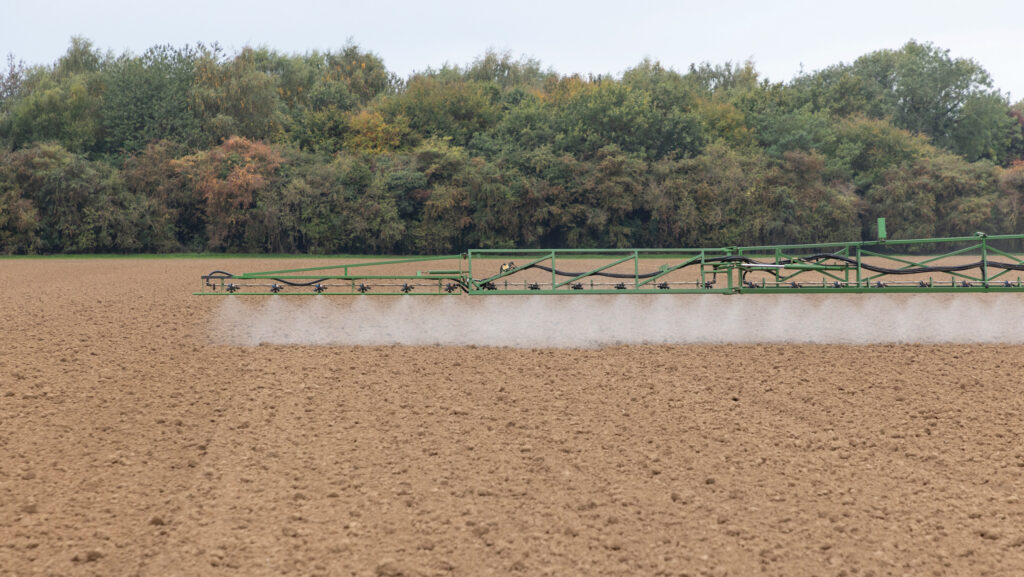Crop Watch: How a new herbicide fits in weed control plans
 © GNP
© GNP The kind, dry autumn conditions continue with wheat drilling nearly complete in many areas.
Favourable conditions have seen some fields after maize that were destined for spring barley to be drilled with wheat while north of the border, farmers are taking advantage by liming land for spring cropping and carrying out drain repairs.
This autumn sees the arrival of a brand new herbicide and some of our agronomists consider how it fits in with weed plans.
See also: Why biscuit brand is rewarding farmers for regen wheat
West
Dominic Edmond, Matford Arable (Devon/Cornwall)
Since my last Crop Watch report in June, harvest has been and gone, and autumn drilling is nearly completed.
I wrote back then that the harvest looked like it had potential, and pleasingly that was realised.
There were good yields of grain and straw on the winter crops, although spring barleys were more variable, which looked like being the case back in June.
This year, we had easily the earliest maize harvest I’ve experienced.
Some crops in the drier regions suffered and were coming off in the second half of August, although the majority were harvested by the middle of September in most parts of Devon and slightly later in Cornwall.
Yields of maize varied a bit, but overall yields were average, and with the quality looking reasonable.
With an early harvest of cereals and maize, there has been a great opportunity to allow grass-reseeding, with just enough moisture to allow establishment.
Grass growth in the past month has been strong, with a lot of late silage made to boost stocks, particularly for those that have had to buffer feed.
As I write, it feels like autumn drilling of cereal crops is almost completed. It’s been perfect conditions for sowing in the past two to three weeks, as good a sowing period as I can recall.
Weed control
Most crops have gone into good seed-beds, and the weather has given the opportunity to get pre-emergence herbicides on the winter barleys-mainly pendimethalin/picolinafen products, but also some flufenacet/diflufenican mixes.
Similarly, wheat crops have had the same approach. Fortunately, blackgrass isn’t a big issue in my area, which makes the approach more straightforward and cheaper.
Crop establishment has been quick this year, and some crops have had an early post-emergence herbicide and aphicide together.

© GNP
There are plenty of aphids about, reinforced by the Rothamsted aphid reports, so this will be a year to be vigilant about the barley yellow dwarf virus threat.
There are also reports of high gout fly numbers just to add to the mix. The plus side is with the relatively dry conditions, slug pressure has been lower, with only a few incidents where slugs have been active.
After three consecutive difficult autumn sowing periods, it’s a relief to experience the easiest one for a number of years.
East
Ryan Baker, Frontier (Suffolk/Norfolk)
Autumn 2025 has been marked by exceptional drilling conditions. The weather has allowed drilling to continue after maize and roots with minimal issues.
We have been lucky that the good conditions have been interjected by rainfall events that have aided both seed-bed conditions and efficacy of pre-emergences.
The approval of two brand new actives in Fundatis (beflubutamid + bixlozone ) has boosted the armoury against grass and broad-leaved weeds in cereals.
The opportunity is being taken to trial Fundatis both against, and in sequence, with current actives. The fact the product turns grassweeds pink is a very visual indicator of its activity.
Drilling started a week earlier this year and by the end of the second week of October the east was 85% drilled. Additional opportunities have been taken by many growers to drill wheat in fields after roots and maize originally destined for spring barley. Winter beans are also currently being established into excellent seed-beds.
The open autumn quickly shifts focus to aphids. Milder weather is allowing aphid numbers to build.
T-Sum-170, the accumulation of 170 day degrees above a threshold of 3C from crop emergence, will be reached quickly and indicates the likely arrival of the second generation which will spread the virus.
This is the time to check for the presence of aphids in your cereal crops. Top-up herbicide applications will also be considered.
Flea beetle
Cabbage stem flea beetles and slugs were noticeable in their absence in oilseed rape this year.
There was some damage noted to later drilled crops, but the majority of these are now well established.
There are two crops in the ground; those nicely established with four to six true leaves or those at welly boot height.
These forward crops have been treated with a plant growth regulator to encourage strong rooting going into the winter.
At the time of writing, phoma levels are low; however, the warm conditions and damp nights will increase the risk of its development.
Most oilseed rape crops are clean of broad-leaved weeds and the canopy is proving to be competitive against grassweeds.
The milder conditions mean we are nowhere near propyzamide application yet.
Consideration must be given to getting the herbicide down to the soil through thicker canopies once soil temperature and moisture allows.
Early beet yields have been encouraging with sugars in the high teens. Mild conditions will support continuing yield gains for later lifted crops.
North
Greg Dawson, Scottish Agronomy (East Scotland)
The theme of recent Crop Watch reports has been the elevated risk of weeds, pests and virus caused by early drilling and mild weather.
More positively, many Scottish growers have benefited from the cultural control opportunities afforded by an early harvest and dry weather.
Time to create stale seed-beds and clean stubbles with glyphosate is normally at a premium north of the border – not so this year.
This has benefits for several challenging issues including grassweed control and dealing with the potato groundkeepers that have emerged in abundance in some cereal stubbles.
Controlling the latter has an essential role in protecting the land bank by limiting potato cyst nematode multiplication and removing a potential source of disease.
This is to the benefit of potato producers and to businesses who wish to continue renting them suitable land.
Crop nutrition
With such a strong focus on crop protection in recent weeks it would be easy to overlook another important component of crop management, nutrition.
Fertiliser inputs typically account for half of variable costs in winter wheat and frequently an even higher proportion in spring cereals.
Planning is needed to ensure that crop needs are met across the rotation, and that return on this substantial investment is maximised.
The early harvest provided growers with an opportunity to carry out essential activities that improve plant access to nutrients.
Identifying and correcting pH problems, drain repairs and dealing with compaction within the cultivation depth could all be considered before releasing the handbrake on the drilling tractor.
As dry weather continued well into October, lime spreading and drain repairs have also been possible for land destined for spring cropping.
As more typical autumn weather sets in and field work draws to a close for combinable crop producers, making time to review whole rotation fertiliser plans with a Facts-qualified agronomist could pay dividends.
Tightening margins and changes to cropping plans shine a spotlight on this important crop management action.
South
Oli Pilbeam – CCC and CLM (Kent and Sussex)
It’s been a long time coming…but finally we have had a drilling campaign we can remember for all the right reasons.
Planned autumn cropping, for once, turned into actual cropping, with the best seed-beds for many years.
Oilseed rape was planted from 1-15 September to ensure it emerged after peak flea beetle migration, and it all looks great.
Best get those bird scarers dusted off and, dare I say it, give some thought to growth regulation!
Wheat drilling started here in late September. With the benefit of hindsight, perhaps 10 days too soon, but it’s understandable, with growers scarred by the past couple of years when we delayed only to see it rain and rain and rain.
The downside of drilling early is, of course, the blackgrass and ryegrass problems it could bring. I expect this year to be a true test of the limited chemistry we have in our armoury.
Pre-emergences were applied on time in great conditions – I adopted an aclonifen and flufenacet-based programme as a starting point, made more cost effective now with label changes and cheaper generics available.
Supply has been tight, but credit to my independent buying group, Crop Advisors, which secured requirements effectively.
On fields more susceptible to blackgrass, we added Avadex (tri-allate) at pre-emergence, topped up with Luximo (cinmethylin) at peri-emergence.
The advantage of having a longer spraying window allows us to ‘stack’ herbicides to increase longevity – a luxury when compared to previous years.
Aphids
Early sowing increases the risk of barley yellow dwarf virus, so as I write we’re on the lookout for aphids – and are likely to apply an aphicide plus or minus any top-up herbicide to double down on blackgrass and ryegrass control.
I’m hopeful the new Fundatis product from FMC will be a useful addition to ryegrass and groundsel control, although used sparingly considering the cost.
We are even contemplating replacing spring barley with more second wheat after good grassweed chits and a wheat price of £25/t over malting barley.
Frankly, having crops looking good is one of the few positives when the bigger picture is still grim, not least because of relentlessly tight margins.
Velcourt shrinking its funded farming businesses by 20% sums up the state of the sector. Unfortunately, I’m not surprised.
All contracting agreements I’m currently appraising, big and small, indicate a distinct lack of shareable profit.
Market fluctuations and the ever-increasing cost base are exposing businesses to much risk, so it’s time for some lateral thinking, to extract as much as possible from any “guaranteed” sources of revenue, while forensically analysing costs.

